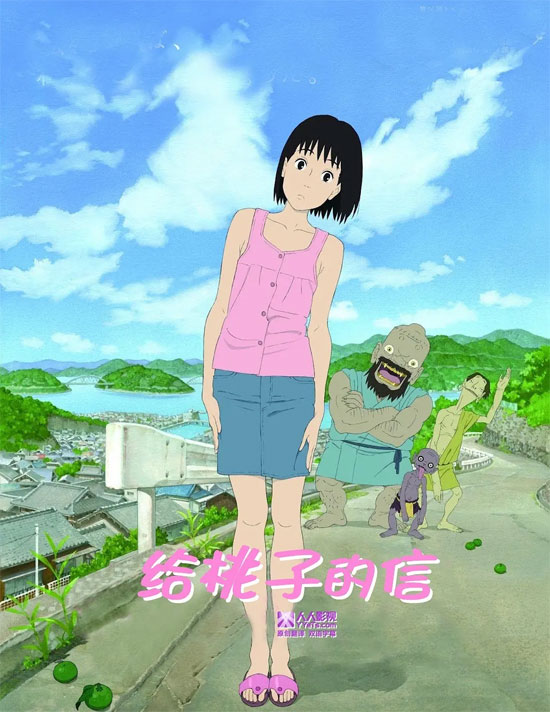Film Name: 给桃子的信 / A Letter to Momo / Momoe no tegami

On a small island off the coast of Shikoku, Japan, a girl named Momo who moved from Tokyo wears a melancholy expression and avoids talking to others. She carries the longing for her father, the guilt over having argued with him before his death, and a letter he left her—bearing only the opening words “To Momo.” How will she regain her vitality? How will she free herself from that guilt? How will she bravely start her new life? How will she make new friends? How will she discover the message her father intended to leave her… “A Letter to Momo” tells such a story rich with the flavor of life.
The island’s breathtaking scenery and simple, kind-hearted people are enchanting and captivating. Perhaps only such an environment could help Momo untangle her emotional knots, and perhaps only such a setting could offer healing to viewers weary of modern life’s restlessness and disconnect from the earth. This is an animated film for adults, for it presents vivid relationships and nuanced emotions. More importantly, compared to today’s increasingly flashy 3D effects and grand-themed heroism in animation, it stays grounded in reality. Whenever I see that simple, tidy shrine atop the small island mountain—unimposing yet standing steadfast amidst lush forests and earth—I realize we’ve come full circle: what people truly need most are these grounded, relatable things to find belonging and warmth for the soul.
The film cleverly incorporates several supernatural creatures from Japanese Shinto mythology, infusing this realist narrative with surreal animated touches. It also injects a touch of humor into its serious themes of melancholy and liberation, growth and self-discovery. These creatures may appear fearsome, yet their hearts burn with warmth; they are loyal, compassionate, and understand the value of sacrifice. This isn’t the first time Japanese animation has portrayed these creatures thus. Once meant to frighten, these spirits have fully become symbols of Japan’s aesthetic unity of beauty and ugliness. Their encounters, bonds, mutual aid, and partings with humans consistently inspire new tales of beauty.
When did Momoko in the story begin to gradually untangle her emotional knots? I believe it likely began when she and several yokai reached the mountaintop and beheld the breathtaking panorama of the island. During the ending credits, she ascends that vantage point once more with her mother. Thus, this marks a pivotal plot point. Another crucial moment is the cliff dive. From her initial avoidance of the jump, to her second missed appointment, to her solitary practice leaps from the shore rocks, culminating in her final courageous and exhilarating plunge. What she needed wasn’t just the courage to leap from the bridge, but the courage to move beyond the shadow of her father’s death and keep life moving forward. What she plunged into wasn’t merely the azure sea, but the broader future of her life. Just as the monster said when giving her a push during practice: “That was a pretty good jump!”
In truth, the monsters not only had to protect Tōko’s safety but also ease her guilt, allowing her to grow. It’s hard to imagine this was a task assigned by heaven; perhaps we should see it more as her father’s wish. Just like the letter she finally received, carried away by the lantern on the boat—written on the little monster’s stationery, yet bearing her father’s blessings. I always felt that her father’s hearty smile bore a striking resemblance to the largest demon’s wide-open mouth—this couldn’t be mere coincidence.
When the three spirits completed their mission and returned to the heavens, the clock hanging on Momoko’s wall—which hadn’t moved in ages—jumped from 5:59 to 6:00 and chimed the hour. That chime rang as clear as Momoko’s smile when she heard it. Perhaps the clock inside Momoko’s heart, frozen since her father’s passing, had finally started ticking again.
The director also designed a companion for Momoko who could see spirits—the innocent little sister of a male friend. Could this be a continuation of the “My Neighbor Totoro” trope where only young girls perceive strange beings? The spirits’ own theory—that Momoko could see them because she touched them when they fell from the sky—now seems implausible. Why exactly can the little sister see the spirits? Perhaps only the director knows. But regardless, if only Momoko could see them, the story would be too dull. She would become a privileged exception rather than an ordinary person, and the warmth of human connection she experiences wouldn’t resonate or spread to others.
It’s worth noting that Momoko’s mother suffers from asthma. At the film’s conclusion, when Mom’s asthma flares up due to her intense concern, I was deeply moved. Having experienced asthma myself as a child, I deeply empathized with the suffocating agony depicted in the film. Yet I am not a parent myself. I cannot fathom the depth of care for one’s own child, nor the hardship of raising a child alone if one’s partner were to pass away. Thus, I sense this mother’s burden—the dual weight of physical pain and emotional toil—and truly feel compelled to acknowledge how incredibly difficult her journey must be.
This film took seven years to create. Its intricate conception and delicate emotions speak for themselves, but its ending alone features “three” distinct moments—a testament to the film’s internal cohesion and the director’s reluctance to let this work conclude. First, after Tōko sends away several monsters, the family bell rings, and she finally reveals a genuine smile… Second, on the nighttime shore, villagers perform an ancient ritual, crafting boats from straw to convey their thoughts to the gods. Yet one boat is washed back ashore by the waves, carrying a letter… Third, on a bright, sunny day, Momoko dons a swimsuit and, encouraged and watched by her friends, leaps from the bridge into the sea…
Please specify:Anime Phone Cases » A Letter to Momo 2011 Film Review: Life requires the spirit of a diver.